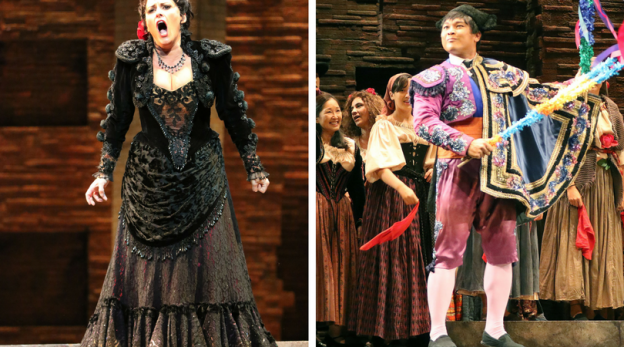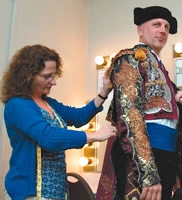
#HOTVillage: Carmen Costumes!
It takes a bunch of talented, skilled people that you never see or hear to pull these things off. There’s a lot going on that the audience doesn’t see. That’s what we are. We’re the people you don’t see. And we don’t want to be seen. We want to have these transitions happen and appear like magic, to some extent. Being the support role is what we do.” – HOT Director of Production Rob Reynolds
Because producing an opera truly takes a village, #HOTVillage gives you an intimate look at one piece of production for each HOT opera! In this piece, we take you behind the scenes with HOT’s costume department. Enjoy this video and Q&A with HOT’s Costume Director Helen E. Rodgers.
 Tell me a little bit about the costumes for this production of Carmen.
Tell me a little bit about the costumes for this production of Carmen.
When I was looking for a set of costumes to rent, I learned that Opera Omaha who had an older set. They said they were planning to fold it into stock , but they would be willing to sell it to us. So I arranged for that to happen. The package that Omaha owned was originally designed for New York Opera, by Eduardo Secano. It’s the first set of costumes we own here at HOT. They shipped it on the first of August. It came in about 30 boxes.
When it arrived, my crew and I unpacked everything and sorted it all into types – meaning shirts with shirts, and pants with pants – measured everything for size, and then started assigning it to the people who we have in the show. When I left, I knew what people we did not have costumes for and what the package didn’t include, which was some lead things – some chorus things. They did have all the soldiers we needed, all the processional costumes at the end, which are really quite spectacular, a chunk of leads, a chunk of chorus, and the entire children’s chorus. Then I left with, essentially, a list of what costumes I still needed. I went to the costume shop Malabar and pulled the remaining costumes we needed for the look of the piece. When all those were shipped here, we started up with fittings.
How long did the unpacking take?
The Omaha stuff took two days to unpack with a crew of four. That included some measuring and hanging, because nothing was shipped on hangers. And then it took another few days to measure and label everything before we started sewing it. The Malabar items from Canada probably took a day, because it was already assigned.
How many costumes are there in Carmen?
Let’s see if I can get these numbers right – we now have 20 men in the chorus, 21 women, 18 children including one child super, and 10 leads – many of whom have 3 different looks. So if you do that math, it’s a lot of clothes!
But some of the chorus looks repeat, like the chorus in Act I is cigarette girls. The cigarette girls are basically in an underwear look. Traditionally, the premise in Carmen is that they’re factory workers. It’s hot in the factory, so during the course of the day, they’re working with other women, and they strip down to be more comfortable. Which is why, in Act I, we find the men waiting to come find them on break. Not only are they known to be open for romance, they also might be scantily clad. So all of those underwear outfits they then wear later as a petticoat under their other looks.
There’s also a super quick change between Act III and Act IIII. There’s a musical interlude just short of two and a half minutes. In that time, just about everyone in the show goes from being a smuggler in the mountains – all layered up – to getting ready for the bullfight scene. And while it’s not too hard to change people in two and a half minutes, it is hard to change 48 people in two and a half minutes. So a lot of them are layered up in such a way that they can simply remove pieces.
Do you have any favorite costumes?
A lot of times, companies will skip the procession at the end of the opera. But if you skip the procession, you don’t have as much of the flashiness, or the visual, but you still have the emotion of the piece. We are doing the procession onstage, and the costumes we got for the matadors and picadors are beautiful! They are satin, they were embroidered, and they were sequined over and beaded. Escamillo’s is from that set. Carmen’s black dress is from that set. They’re just lovely.
If you had to guess retail value for those pieces, what would you guess?
If you had it built in a shop today, in a New York shop, I would say each costume in that set would probably be $5,000, which is why this was such a wonderful find.
The value surprises a lot of people. But if you think about it, if a man is wearing a suit or a woman a full outfit, and you just add up everything they’re wearing from head to toe, then it usually makes a bit more sense to people how much costumes cost. All of these items are custom tailored, so that’s factored into the value, as well.
Why do you enjoy working with costumes?
I have been doing this for a little over 35 years professionally. I studied costumes – I went to the College of William & Mary. I was interested in fashion, and I was interested in theatre. I ended up taking costume design courses and thought, ‘this is even better!’
The wonderful thing about opera is that so many pieces are set in a historical period. It’s fun to take a walk into that period and figure out what people wear. It’s of course the most fun for me as a designer when I get to design and build things, but few opera companies can afford that kind of work anymore. Assembling things so that they look like they all were meant to be together is also artistry. I’ve done shows where we have six or so sources or costumes, and the idea is that it’s all a cohesive look up there. That kind of thing requires some attention. Because I have a musical background, I appreciate the music in opera. It’s come to be the theatrical performance that I prefer. Opera is like being home.
Why do you think audiences here should see this production?
It’s a wonderful cast. It’s a great opera for people who know the opera, because they know the music. But it’s also a great first opera, because so much of the music is familiar. It’s being used right now in a couple commercials you’ll hear. It’s a great one to bring people to introduce them to opera. It’s got all the big moments – it’s got love, it’s got passion, someone dies at the end – oh, was that a spoiler?
